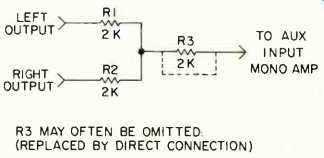by Joseph Giovanelli
Matching Headphone to Amplifiers
Q. I have headphones rated at 250 ohms which I would like to use with my amplifier's front panel headphone jack. Do I just install resistors in series with the jack, and what value should I use? The jack is rated at 8 ohms.
-Steve Anderson, Santa Ana, CA.
A. A source rated for a low impedance (8 ohms) load can drive one of higher impedance (250 ohms) easily. The reverse is not true, however. Matching them in this case will make no improvement in sound, but would lower the signal input into the phones because your amplifier already has resistors in series with its output. These are required to keep from feeding the amplifier's entire output to the phones and blowing them out (and hurting your ears).
Mono Sound From Stereo Tapes
Q. I have a Sony CF550 cassette recorder with line output. I would like to listen to stereo tapes from this unit over my Bogen P.A. (mono) amplifier. It has an AUX input.
-Rudolph Repac, Hillside, N.J.
A. You can play two stereo channels into a single-channel amplifier by using a "Y" connector. Connect two of the connectors of the Y to the line outputs of the tape machine and the other to the AUX input of the mono amplifier. Occasionally this setup will lower the output of the recorder and produce some distortion. In such a case, you should insert an isolating network as shown in the diagram.

Record Noise vs. Pickup Output
Q. I have a Dual turntable, Micro Acoustics QDC-1E pickup, and a Pioneer SA-9100 amplifier. Because of the low output of the cartridge, I must turn the volume up to between one and three o'clock. The surface noise of my discs is sometimes annoying, and I often hear a low-frequency rumbling. These noises change with different records, from nearly inaudible to terrible. Can this be turntable rumble, or it is groove noise (stylus friction) because my volume control is set too high?
-Michael Bartholomew, Hellertown, PA.
A. The relatively small signal output of your cartridge has no bearing on how much record noise the cartridge transmits to the rest of the sound system. The cartridge produces record noise and desired signal to the degree that each is present on any given recording.
The fact that some discs produce more of this noise than others indicates that the problem you have is actually with the discs, as the problem varies from one to another. Some low-frequency noise is on the discs themselves, either because of problems during mastering or, more likely, problems in the pressing process. In this case, the rumble-like noise will be more like a roar than a rumble. When you have fine equipment, flaws in discs are heard more easily (Of course, the good things are also revealed.).
(Audio magazine, Sept. 1975, JOSEPH GIOVANELLI)
= = = =